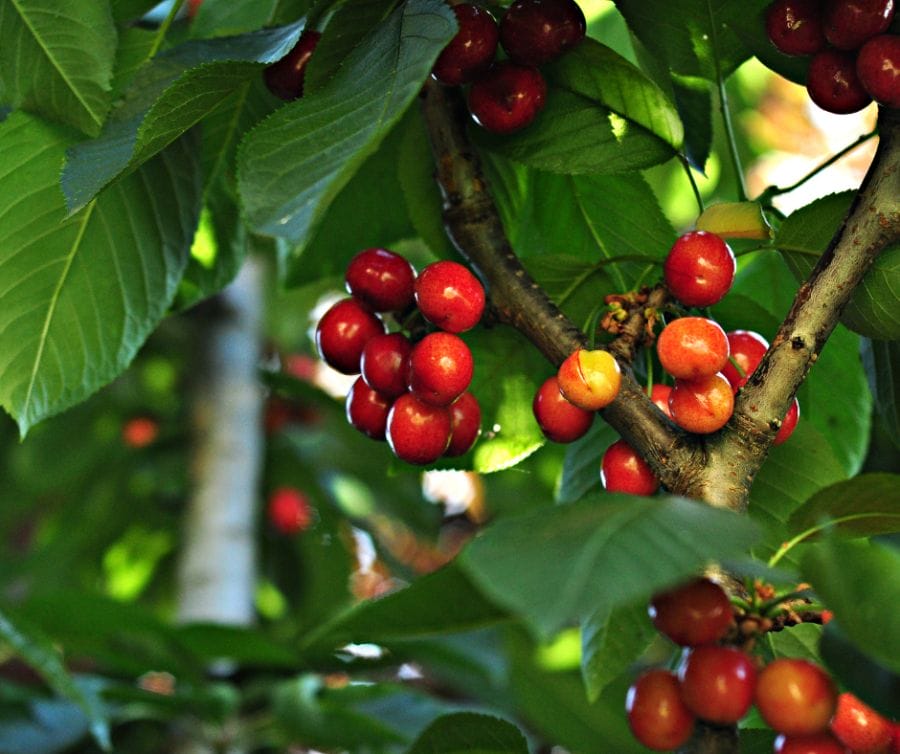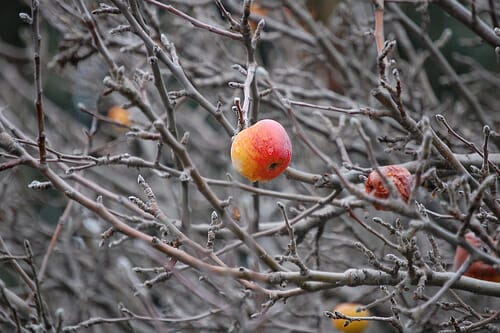TL;DR:
- Winter is the best time to prune fruit trees in Oregon. Trees are dormant, making it easier to shape them and reduce the risk of disease.
- Basic pruning involves: removing dead/diseased branches, crossed limbs, water sprouts, and suckers.
- Safety first! Use professional-grade tools (shears, loppers, saw) and a sturdy ladder. Avoid pruning too high.
- Don’t know what to do with surplus fruit? Donate it to the Portland Fruit Tree Project, which helps those in need.
When to Do It & What to Do With Extra Fruit
In this article, our certified leading arborists discuss why December and January are the ideal months for dormant season fruit tree pruning. Read on for professional fruit tree pruning tips, including whom to contact for tree pruning services. We also discuss a common conundrum for fruit tree owners: What to do with excess fruit.
Why Prune Fruit Trees in the Winter? Strategic annual pruning is important for all fruit trees in Oregon. Winter is the best season for pruning fruit trees because this is when they are completely dormant. During the cold months, the plant is in an inactive state, storing up energy for the following growth cycle. Energy gathered from summer sunlight is stored in the tree’s root system. At the end of the branches, new buds are starting to form for the next spring growth and fruiting cycle. Winter is well-suited for structural training branches to grow into the shape of your choice, removing water sprouts (branches growing straight up), and eliminating crossed branches.
DIY Fruit Tree Pruning Tips From A Tree Care Expert. You may have heard that tree trimming is best left to professionals. This is generally true, but as Portland tree pruning experts, we consider basic fruit tree pruning accessible for most homeowners.
Safety First. Of course, you should always prioritize safety first when pruning. Working at height is rife with serious fall hazards. Assuming you’re following proper safety precautions, it’s empowering to learn how to properly prune and structurally train your fruit trees.
Here are some useful fruit tree pruning tips for those in the DIY crowd:
1. Use the Right Tools. Of course, pruning requires a set of quality pruning shears, as well as a sharpening stone to keep the blade razor sharp. You may also want a quality pair of heavy-duty two-handed loppers (AKA brush cutters) and a professional pruning saw. Expect to pay between $100 and $250 in total for these three essential items. Additionally, you might need to purchase a stable three-legged pruning ladder to safely access upper branches.
2. Understand the Basics of Pruning. Growth hormones dictate plant growth, so understanding the flow and cycle of these hormones is paramount to understanding how your cuts will affect plant growth down the road. With experience, you’ll get a feel for the art and science of strategic pruning, as you anticipate how the tree reacts to your cuts. This is the expertise that our certified arborists have spent decades honing. The fundamental basics, for beginners to keep in mind, follows.
You’ll definitely want to prune away infected and diseased, and dying branches. Crossed limbs should also be removed. Next, cut away water sprouts and suckers, which grow near the base of the trunk, from the roots, or at the top of the tree. Finally, imagine throwing a cat through the tree. It may sound crazy, but this visual is a good rule of thumb to remember how much to prune away. You can also visualize where you want the tree to look in the next five years, and remove branches that don’t fit that vision. Such selective pruning will help to open the center of the tree to improve air circulation and sunlight absorption.
 Proper Portland tree pruning is all about purposefully cutting into the branch. Avoid cutting into the branch collar, a swollen, wrinkled area that forms where the branch and trunk meet. This is where the tree naturally heals from a cut. To prevent heavy branches from breaking (and inviting disease), use three cuts:
a) Place the blade about an inch above the branch collar on the underside of the branch you wish to remove.
b) Cut all the way across the branch, cutting from the topside of the branch down, with the blade just beyond the first cut you made.
c) Finally, cut away the nub, slicing off the section remaining above the branch collar.
Proper Portland tree pruning is all about purposefully cutting into the branch. Avoid cutting into the branch collar, a swollen, wrinkled area that forms where the branch and trunk meet. This is where the tree naturally heals from a cut. To prevent heavy branches from breaking (and inviting disease), use three cuts:
a) Place the blade about an inch above the branch collar on the underside of the branch you wish to remove.
b) Cut all the way across the branch, cutting from the topside of the branch down, with the blade just beyond the first cut you made.
c) Finally, cut away the nub, slicing off the section remaining above the branch collar.
3. Know your limits. Even with a good stable pruning ladder (the three-legged variety), pruning at the top of the ladder can be scary, risky, and downright dangerous. Don’t exceed your safety limits. If the situation feels unsafe, then it’s probably best to call a fully licensed and bonded professional tree expert who carries their own comprehensive liability insurance.
What to do with Extra Fruit. Excess fruit can be a hassle to deal with. If you simply cannot use or harvest all the fruit your tree produces, there is a charitable solution: the Portland Fruit Tree Project. This inspirational community-focused non-profit group registers Portland nut and fruit trees, harvests their crops, and distributes the proceeds to those in need. We are happy to help the Portland Fruit Tree Project harvest thousands of pounds of fresh fruits and nuts per year. The Portland Fruit Tree Project also hosts hands-on workshops to teach homeowners about the best care and preservation of their fruit trees in Portland.
How the Leading Arborists at Urban Forest Pro Can Help. We wish you the best of luck as you learn more about dormant season winter pruning and fruit tree care in general. If you have any questions or would like a professional health checkup for your fruit trees, we would love to help. Contact us today to schedule a visit from one of our certified arborists.
What Our Clients Say About Us
“Dalton and James did an excellent job. They completed the work professionally and respectfully. They cleaned up perfectly. I really appreciated them both very much and highly recommend them!! Thank you”
Kathryn D.
Rating 5/5 ⭐⭐⭐⭐⭐
See our 4.8 rating and read more of our 196 reviews on Google!
